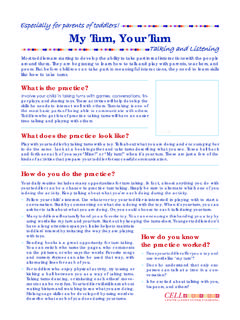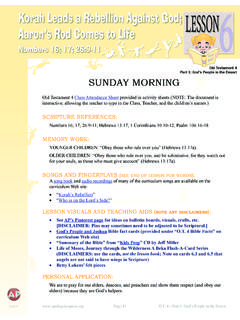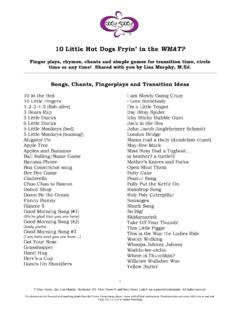Transcription of FLIP CHART - Connecticut
1 Connecticut State Department of Education flip CHART Preschool Assessment Framework Performance Standards and Description of Benchmarks for 21/2- to 6-Year-Old Children 2 PERSONAL AND SOCIAL Performance Standard BENCHMARKS FOR 2 - TO 6-YEAR-OLD CHILDREN P & S 1 Selects and uses a limited range of familiar materials; uses some new materials with direction and encouragement Selects familiar materials; participates in unfamiliar activities with teacher support Usually participates in both familiar and unfamiliar activities Independently selects and participates in a wide variety of activities; requests additional materials to extend work Shows self-direction with range of materials Usually selects small range of familiar materials.
2 May use or refuse less familiar materials when teacher invites and supports child s involvement. Takes own truck from cubby and pushes it around room. Observes others using sand toys; then plays briefly next to peer after demonstration of shovel by teacher. Sits by teacher when invited to join new play dough activity; briefly touches materials and leaves. Engages in an increasing range of both familiar and unfamiliar activities. Often chooses to work/play in a variety of centers in room. When teacher suggests that child join her and play with new, more challenging puzzles, chooses one and starts to do it. On own, chooses wide variety of familiar materials; tries new materials with either teacher or peer support.
3 May experiment by combining materials. Often selects and uses play dough on own; experiments by adding buttons and plastic straws from art area. Regularly uses swing; tries new group tire swing with friend s encouragement. Usually comfortable with regularly available classroom materials. Actively experiments, often without need for encouragement. Selects new marble track and experiments without teacher introducing it. After class visit to farm, initiates building a farm in block area with peers and asks teacher for 1 colored cubes to decorate farm. Using computer, opens new program on own and tries to use it. 3 PERSONAL AND SOCIAL Performance Standard BENCHMARKS FOR 2 - TO 6-YEAR-OLD CHILDREN P & S 2 Sustains attention primarily to self- selected, high interest tasks Sustains attention to high interest, self-selected task until complete or reaches frustration level Sustains attention to variety of self-selected tasks until complete, despite some frustration Persists with both self-selected and teacher-directed tasks until task completed Sustains attention to task/goal that child has set out to accomplish Likely to change activities frequently.
4 May often move from one activity to another without completing task. With teacher s encouragement, paints at easel for 2-3 minutes; then moves to block center. Puts in 2 pieces of unfamiliar 5-piece puzzle, then moves to water table. Sits for 5 minutes and turns each page of favorite book brought from home while telling self own story. May need adult encouragement to complete demanding task. If having difficulty completing a simple puzzle, stays to complete when teacher suggests and helps with a different strategy. Continues to work on completing a collage for 10 minutes with familiar adult at table encouraging him or her. Works on building roads and houses in block area throughout center time.
5 Experiments with new magnets for 15 minutes in order to examine prediction about which objects will be attracted to magnets. Works on a challenging puzzle for 20 minutes until completed without teacher prompting. Builds and rebuilds block airport throughout activity time until it can hold planes without breaking. Stays with task or activity that may take several sessions to complete. Returns to activity after a break or interruption. Starts to make a bird feeder and completes it the next day. Returns to finish listening to a book-on-tape after lunch. After teacher gives directions, works on and completes a drawing and story with phonetic spelling of several words.
6 4 PERSONAL AND SOCIAL Performance Standard BENCHMARKS FOR 2 - TO 6-YEAR-OLD CHILDREN P & S 3 Stays briefly in interactive, high interest activities with small group (up to 5) with teacher encouragement Joins small group (up to 10) in high interest activities; usually participates Willingly participates in most whole-group activities; has difficulty waiting turn Actively participates in whole-group activities and usually waits turn Participates in teacher-led group activities Comes to group when invited; may wander off unless activity is of special interest or sits next to teacher. Observes and/or participates in creative movement activity for a few minutes while standing next to teacher.
7 Joins teacher and 2 peers and tries to do familiar fingerplays for 5 minutes; goes to sand table as teacher starts to demonstrate new fingerplay. May come to group on own and can remain for at least 10 minutes if sitting next to familiar peer or teacher. Often is distracted, responds out of turn, or gives responses that may not be connected to activity. Tries to sing 3 familiar songs with group; then starts to play with ball in her or his pocket. Listens to a high interest story for about 10 minutes while sitting next to friend. Joins circle game; may observe new game several times before attempting to play. Listens and responds with words or actions related to activity.
8 Sometimes acts appropriately by waiting turn and giving responses connected to ongoing activity. Participates in series of 3 finger plays, repeating all words and movements; attempts a few words and movements when less familiar. After listening to a story Whistle for Willy, when asked to move like a dog, shouts, I have a cat named Ginger! Joins in most large-group activities. Usually listens attentively, waits turn and responds appropriately to teacher directions. Waits turn to hold baby chick visiting classroom. When teacher reads book about vacations, shares details of own vacation. This summer I took a jet plane with my mom. Grandma met us at the airport in Chicago.
9 When peer is sharing about favorite ice cream, shouts out, Mine is pistachio. 5 PERSONAL AND SOCIAL Performance Standard BENCHMARKS FOR 2 - TO 6-YEAR-OLD CHILDREN P & S 4 Makes transitions and follows basic routines and rules with teacher supervision Makes transitions and follows basic routines and rules with occasional reminders Makes transitions and usually follows routines and rules when given signal Anticipates transitions and usually follows routines and rules independently Manages transitions, follows routines and rules Usually able to transition and follow simple routine or rule when supported by an adult. Washes hands before lunch when accompanied by teacher.
10 Puts away materials with teacher help. Reluctant to stop water play for snack. Leaves water table with sponge and pail in hand, and returns to water table when group transitions to story. Usually makes transitions and follows basic routines and rules; may need prompting with both signals and reminders from teacher. Responds appropriately to teacher requests. Puts away materials before going out-doors with teacher reminder and signal from timer. When asked by teacher, joins circle time on rug. Uses quieter voice in block area after teacher reminds child to use indoor voice, please. Knows what to do without additional reminders or signals. Gets sponge to wash table in response to cleanup song.
















